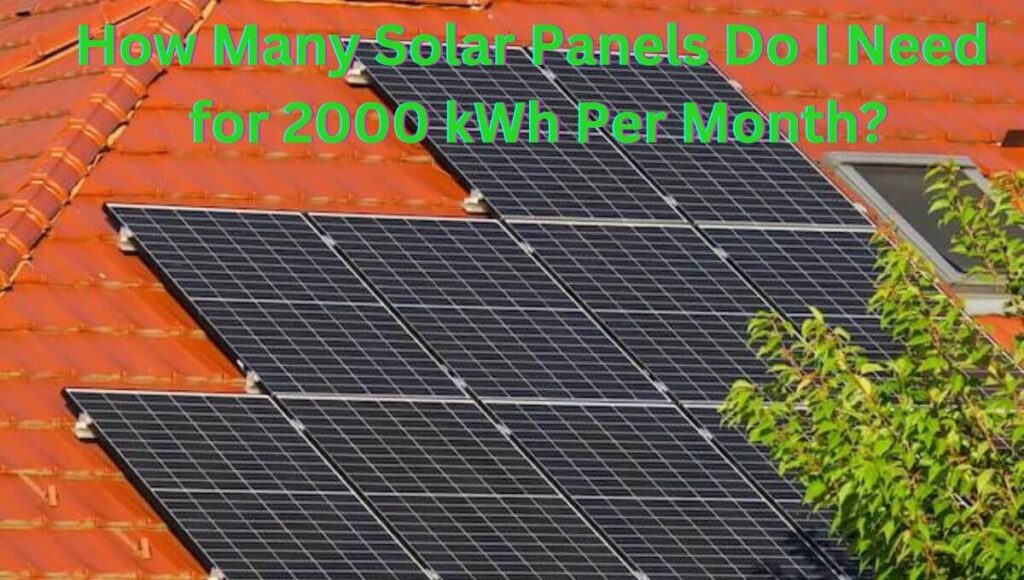Last updated on March 4th, 2025 at 11:37 pm
“Ever found yourself pondering, ‘How Many Solar Panels Do I Need for 2000 kWh Per Month?‘ That’s the burning question for anyone eyeing the sun as a powerhouse for their energy needs. Picture this: a home buzzing with activity, gadgets running, the AC keeping things cool in the summer heat, and all of it powered by the sun.
Now, you might be thinking, 2000 kWh per month sounds like quite a lot – and you’re absolutely correct. In fact, it surpasses the average energy consumption of a typical US household.
But don’t worry; by the time you reach the end of this article, you’ll not only have a clear picture of how many panels are required for a 2000 kWh per month solar panel system, but also gain insights into the costs, savings, return on investment, and the delightful journey toward energy independence and substantial financial benefits.
Solar Panel Calculator: How Many Solar Panel Do You Need?
(*) Required field

How to Calculate the Number of Solar Panels You Need?
Solar energy has become an increasingly popular and sustainable source of electricity for homes and businesses. One of the critical aspects of planning a solar power system is determining how many solar panels are needed to meet your energy needs efficiently.
Several factors come into play when making this calculation, ranging from your location and energy consumption patterns. Let’s discuss the factors you need to consider before determining how many solar panels you need:
1. Determine your energy need
The first important step is to know how much energy you need to power your home. Your utility bills provide the roadmap to this crucial information. They reveal how much electricity you’ve been using, offering insights into your daily and monthly habits.
Seasonal variations and changes in routines can lead to fluctuations in electricity consumption. Recognizing these trends helps you anticipate higher demands during certain times of the year, allowing you to plan your solar system accordingly.
According to the U.S. Energy Information Administration data, in 2021, the typical U.S. residential electric-utility customer purchased an average of 10,632 kilowatt-hours (kWh) of electricity over the course of the year, which translates to approximately 886 kWh per month. Among the states, Louisiana recorded the highest annual electricity consumption per residential customer, reaching 14,302 kWh, while Hawaii reported the lowest at 6,369 kWh per residential customer.
2. Peak sunlight hours
A peak sun hour is defined as the time when the sun’s strength averages at 1,000 Watts of photovoltaic power for every square meter.
Peak sunlight hours play a pivotal role in determining how many solar panels you need for an efficient solar energy system. These hours represent the period during the day when the sun’s intensity is at its highest, allowing solar panels to generate electricity most effectively. The number of peak sunlight hours varies by location and significantly influences the amount of energy a solar panel system can produce.
In regions with more peak sunlight hours, such as the southwestern United States (e.g., Arizona and New Mexico which have average peak sun hours is more than 6), solar panels can generate electricity for a longer duration each day. Consequently, fewer solar panels are needed to meet a given energy demand.
Conversely, in areas with fewer peak sunlight hours, like the Pacific Northwest (e.g., Washington and Oregon which have average peak sun hours is almost 4), solar panels have less time to generate electricity at their maximum capacity. To compensate, more solar panels are required to generate the same amount of energy.
3. Wattage of solar panels
When it comes to calculating how many solar panels you need, the wattage of the solar panels is a fundamental factor. The wattage, or power rating, of a solar panel indicates how much electricity it can generate under standard conditions.
Residential solar panels typically have wattages ranging from 250 watts to 400 watts. The most common wattage range for residential panels falls between 300 to 350 watts. These panels are designed to efficiently convert sunlight into electricity for use in homes. So, if you have a 400-watt solar panel, it can theoretically produce 400 watts (0r 0.4 kilowatts) of electricity per hour under ideal conditions.
4. Losses of energy
A solar panel system, despite its advanced technology, encounters losses that typically 24% of its potential electricity production. These losses represent the difference between the theoretical maximum energy that could be harvested from the sunlight hitting the panels and the actual usable electricity generated.
Energy losses in a solar panel system are primarily caused by a combination of factors that diminish the system’s ability to convert sunlight into electricity efficiently. Shading, whether from buildings, trees, or obstructions, interrupts the sunlight hitting the panels, leading to reduced output.
High temperatures can cause the panels to lose efficiency as they heat up. Accumulated dust, dirt, or debris on the panel surfaces can hinder sunlight absorption, while inverter inefficiencies and electrical losses in wiring and connections further contribute to the overall losses. Over time, panel degradation and aging, as well as the occasional reflection and glare, can also affect the system’s performance.
Let’s calculate how many solar panels you need
Let’s imagine that, like a typical US resident, your average energy consumption per month is 886 kWh.
If we consider a 24% loss of the total energy production, then your solar panel system needs to produce (886+886×24%)=1098.64 kWh of electricity per month.
Now let’s assume that the wattage of each solar panel is 400W or (400/1000) 0.4kW, which means each of your solar panels can generate 0.4 kW of electricity per hour.
Let’s suppose you are living in an area where the peak sun hours is 5.
Now a single solar panel of 400W can generate =5×400 W=2000Wh or 2 kWh per day.
It can produce (2×30)=60 kWh per month.
But your monthly energy need with a 24% loss is 1098.64 kWh.
Number of solar panels you need = (Monthly energy need with a 24% loss/Energy produced by a single solar panel)=(1098.64/60)=18.31 solar panels.
If you round up 18.31, then you need 18 solar panels of 400 W to meet your energy demand of 886kWh per month.
How Many Solar Panels Do I Need for 2000 kWh Per Month?
Let’s follow the above calculation:
Your energy consumption is 2000 kWh per month.
If we consider a 24% loss of the total energy production, then your solar panel system needs to produce (2000+2000×24%)= 2480 kWh of electricity per month
Let’s imagine that the wattage of each solar panel is 400W or (400/1000) 0.4kW.
Let’s suppose you are living in an area where the peak sun hours is 5.
Now a single solar panel of 400W can generate =5×400 W=2000Wh or 2 kWh per day.
It can produce (2×30)=60 kWh per month.
But your monthly energy need with a 24% loss is 2480 kWh.
Number of solar panels you need=(Monthly energy need with a 24% loss/Energy produced by a single solar panel)=(2480/60)=41.33 solar panels.
If you round up 41.33, then you need 41 solar panels of 400 W to meet your energy demand of 2000 kWh per month.

What Is the Cost of a 2000 kWh per Month Solar Panel System?
Let’s imagine you need to have a 2000 kWh per month solar panel system which consists of 41 solar panels and each panel has a capacity of 400 W.
Let’s break down the cost of a solar panel system aiming to generate 2000 kWh per month using 41 solar panels, each with a capacity of 400 watts. We’ll consider the average cost of monocrystalline solar panels in the United States, labor costs, and the federal tax credit of 30%.
1. Calculating Total Solar Capacity:
First, let’s calculate the total solar capacity of your 41 panels. With each panel rated at 400 watts, when you multiply 400 by 41, you get a total capacity of 16,400 watts, which is equivalent to 16.4 kilowatts (kW). This is the amount of electricity your panels can potentially generate under ideal conditions.
2. Estimating Panel Costs:
The average cost of monocrystalline solar panels before installation is $1.5 per watt. For a 16.4 kW system:
Total panel cost = Panel cost per watt × Total system capacity (in watts)
Total panel cost = $1.5/W × 16,400 watts = $24,600
3. Additional Hardware Costs:
Apart from the panels, you’ll need other components like an inverter, a battery (if you want energy storage), mounting hardware, and wiring. These costs can vary significantly depending on the specific hardware you choose and your installation requirements. Let’s estimate these additional costs at $5,000.
4. Labor Costs:
Labor costs typically account for about 10% of the total system price. For this system, labor costs are approximately:
Labor cost = 10% of (Total panel cost + Additional hardware costs)
Labor cost = 10% of ($24,600 + $5,000) = $2,960
5. Total System Cost Before Tax Credit:
Now, add up the panel cost, additional hardware costs, and labor costs to get the total system cost before the federal tax credit:
Total cost before tax credit = Total panel cost + Additional hardware costs + Labor cost Total cost before tax credit = $24,600 + $5,000 + $2,960 = $32,560
6. Applying the Federal Tax Credit:
The federal tax credit for solar panel systems in the US is 30%.
To calculate the tax credit amount, multiply the total cost before the tax credit by 0.30:
Federal tax credit = Total cost before tax credit × 0.30 Federal tax credit = $32,560× 0.30 = $9,768
7. Calculating the Total Cost After Tax Credit:
Subtract the federal tax credit from the total cost before the tax credit to find the final cost:
Total cost after tax credit = Total cost before tax credit – Federal tax credit Total cost after tax credit = $32,260 – $9,678 = $22,882
So, the total cost of a 2000 kWh per month solar panel system with 41 panels of 400W each, including panels, additional hardware, labor, and before the federal tax credit, is approximately $32,560. After applying the 30% federal tax credit, the final cost comes down to approximately $22,882.
What is the payback Period of a 2000kWh per Month Solar Panel System?
To calculate the payback period for a 2000 kWh per month solar panel system, considering a system cost of $22,882 after the federal tax credit, along with the average electricity rate in the U.S. of 16.11 cents per kilowatt-hour (kWh):
1. Calculate Annual Savings:
First, determine the annual savings from your solar panel system. This involves calculating how much you would have spent on electricity without the system compared to what you spend with it.
Without the solar panels, your annual electricity cost for 2000 kWh per month at 16.11 cents per kWh would be: Annual cost without solar = 2000 kWh/month × 12 months × $0.1611/kWh = $3,892.64
With the solar panel system, you’re generating 24,000 kWh per year (2000 kWh/month ×12 months). If you’re saving the full cost of electricity, your annual savings would be $3,892.64.
2. Calculate Payback Period:
To find the payback period, divide the initial cost of the system (after the tax credit) by the annual savings: Payback Period = Initial Cost / Annual Savings
Payback Period = $22,882 / $3,892.64 ≈ 5.87 years
If we round up 5.87, we will get 6 years.
So, the payback period for your 2000 kWh per month solar panel system is approximately 6 years. This means you will recover the initial investment in about 6 years through electricity bill savings.
How Much Money Will a 2000 kWh per Month Solar System Save You?
Let’s calculate how much money a 2000 kWh per month solar panel system can save you after the payback period of 6 years, considering the cost of electricity at 16.11 cents per kWh and the average lifespan of solar panels is 25 years.
1. Calculate Annual Savings After Payback Period:
After the initial payback period of 6 years, you’ll continue to save on electricity costs. To calculate the annual savings during the remaining 19 years (25 years total lifespan minus the initial 6 years), we can use the same annual savings figure calculated previously: Annual savings after payback period = $3,892.64/year
2. Calculate Total Savings After Payback Period:
Multiply the annual savings after the payback period by the remaining years to find the total savings for this period: Total savings after payback period = Annual savings after payback period × Remaining years Total savings after payback period = $3,892.64/year × 19 years = $73,957.16.
So, after the payback period of 6 years, a 2000 kWh per month solar panel system can save you a total of approximately $73,957.16 in electricity costs over the remaining 19 years of its 25-year lifespan.
Final words!
The journey towards generating 2000 kWh per month with solar energy is a remarkable and financially savvy choice. With precisely 41 solar panels, each boasting a capacity of 400 watts and basking in an average of 5 peak sun hours, you’re embarking on a path to both sustainability and substantial savings.
The financial equation is equally promising. At an initial cost of $32,560 before the federal tax credit and a reduced $22,882 after availing of the credit, your solar investment starts paying dividends from day one. The payback period, around 6 years, is just the beginning of your financial adventure.
What truly sets this journey apart is what happens after those initial 6 years. Your solar panels don’t just power your home; they power your financial future. Over the 25-year lifespan of your system, your potential savings are staggering. Imagine pocketing over $73,000 on your electricity bills. And here’s the kicker: this calculation is based on today’s electricity rates. With prices expected to climb, your savings could skyrocket even further.

